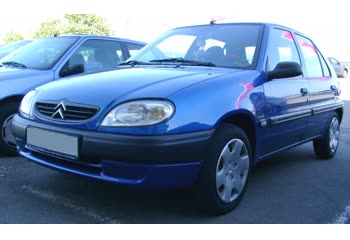Everything you need to know about specifications and performance - Peugeot 106 2000 - 1.5 D (57 Hp)

Overview:
What is the engine capacity of a Peugeot 106 2000?
The engine capacity of the Peugeot 106 2000 is 1527.
Peugeot 106 2000 How many horsepower?
The engine power of the Peugeot 106 2000 is 57 Hp @ 5000 rpm..
What is the Peugeot 106 2000 engine?
Peugeot 106 2000 engine is VJX TUD5. (Click to see other cars using the same engine)
How much gasoline does a Peugeot 106 2000 consume?
The Peugeot 106 2000 consumes 5.1 liters of gasoline per 100 km
General:
Brand: Peugeot
Model: 106
Generation: II (1)
Modification (Engine): 1.5 D (57 Hp)
Start of production: October, 2000
End of production: December, 2003
Powertrain Architecture: Internal Combustion Engine
Body type:Hatchback
Seats: 5
Doors: 3-5
Engine:
Power: 57 hp @ 5000 rpm.
Power per litre: 37.3 hp/l
Torque: 95 nm @ 2250 rpm.
Engine Model/Code:VJX TUD5
Engine displacement: 1527
Number of cylinders: 4
Engine configuration: Inline
Number of valves per cylinder: 2
Fuel injection system: Precombustion chamber injection
Engine aspiration: Naturally aspirated Engine
Valvetrain: OHC
Engine oil capacity: 4.5 l
Coolant: 6 l
Engine layout: Front, Transverse
Cylinder Bore: 77 mm
Piston Stroke: 82 mm
Compression ratio: 23:1
Performance:
Fuel Type: Diesel
Fuel consumption (economy) - urban: 6.9 l/100 km
Fuel consumption (economy) - extra urban: 4.3 l/100 km
Fuel consumption (economy) - combined: 5.1 l/100 km
Emission standard: Euro 3
Acceleration 0 - 100 km/h: 18.5 sec
Acceleration 0 - 62 mph: 18.5 sec
Maximum speed: 158 km/h
Weight-to-power ratio: 15.4 kg/Hp, 65.1 Hp/tonne
Weight-to-torque ratio: 9.2 kg/Nm, 108.6 Nm/tonne
Acceleration 0 - 60 mph: 17.6 sec
Space:
Kerb Weight (kg): 875
Max. weight (kg): 1375
Max load (kg): 500
Trunk (boot) space - maximum: 953 l
Trunk (boot) space - minimum: 215 l
Fuel tank capacity: 45 l
dimensions:
Length: 3678 mm
Width: 1594 mm
Height: 1376 mm
wheelbase: 2385 mm
Front track: 1387 mm
Rear (Back) track: 1310 mm
Powertrain, Suspension and Brakes:
Drivetrain Architecture: The Internal combustion Engine (ICE) drives the front wheels of the vehicle.
Drive wheel: Front wheel drive
Number of gears and type of gearbox: 5 gears, manual transmission
Front brakes: Disc
Rear brakes: Drum
Assisting systems: ABS (Anti-lock braking system)
Steering type: Steering rack and pinion
Power steering: Hydraulic Steering
Tires size: 165/70 R13
Wheel rims size: 13
Front suspension: Wishbone
Rear suspension: Trailing arm
See also

Other generation.
Its production began in 1992 until 1996

Same engine. (VJX TUD5).
Its production began in 1999 until 2003
Write a comment